Matrix, Vector Operations
Big-O
How to measure the impact of n on algorithmic cost?

Let g(n) be a function of n. Then define

That is, if there is a
constant c such that 0 ≤ f (n) ≤ cg(n) is
if there is a
constant c such that 0 ≤ f (n) ≤ cg(n) is
satisfied.
• assume non-negative functions (otherwise add | . |) to the definitions
•  represents an asymptotic upper
bound on f (n) up to a
represents an asymptotic upper
bound on f (n) up to a
constant
• example: 
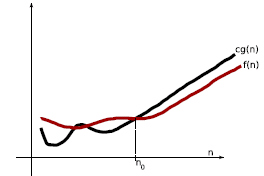
Big-Omega
asymptotic lower bound

Let g(n) be a function of n. Then define

That is,  if there is a constant c such that
0 ≤ cg(n) ≤ f (n) is
if there is a constant c such that
0 ≤ cg(n) ≤ f (n) is
satisfied.
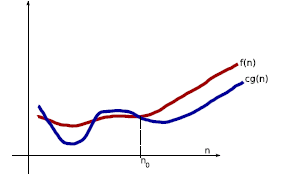
Big-Theta
asymptotic tight bound

Let g(n) be a function of n. Then define

Equivalently, 
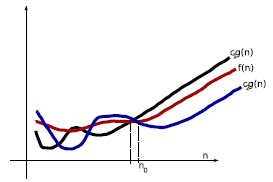
BLAS
Basic Linear Algebra Subprograms (BLAS) interface introduced APIs for
common linear algebra tasks
• Level 1: vector operations (dot products, vector norms, etc) e.g.

• Level 2: matrix-vector operations, e.g.

• Level 3: matrix-matrix operations, e.g.

• optimized versions of the reference BLAS are used everyday: ATLAS, etc.
vec-vec, mat-vec, mat-mat
• inner product of u and v both [n
× 1]

• → n multiplies, n - 1 additions
• → O(n) flops
• mat-vec of A ([n × n]) and
u ([n × 1])

• → n2 multiplies, n2 additions
• → O(n2) flops
• mat-mat of A ([n
× n]) and B ([n
× n])
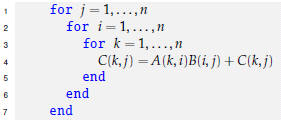
• → n3 multiplies, n3 additions
• → O(n3) flops

matlab test
four tests:
• matrix-matrix multiply
• inner product
• matrix-vector multiply
• n matrix-vector multiplies
order them ...fastest to slowest
testflop.m
• Solving Diagonal Systems
• Solving Triangular Systems
• Gaussian Elimination Without Pivoting
> Hand Calculations
>Cartoon Version
> The Algorithm
• Gaussian Elimination with Pivoting
> Row or Column Interchanges, or Both
> Implementation
• Solving Systems with the Backslash Operator
Solving Diagonal Systems
The system defined by

is equivalent to

The solution is

Listing 1: Diagonal System Solution

In Matlab:
1 >> A = ... % A is a diagonal matrix
2 >> b = ...
3 >> x = b./diag(A)
This is the only place where element-by- element division
(. /) has anything to
do with solving linear systems of equations.
Operations?
Try...
Sketch out an operation count to solve a diagonal system of equations...
cheap!
one division n times  FLOPS
FLOPS
Triangular Systems
The generic lower and upper triangular matrices are

and

The triangular systems
Ly = b Ux = c
are easily solved by forward substitution and backward
substitution,
respectively
Solving Triangular Systems

is equivalent to

Solve in backward order (last equation is solved first)

Solving for  for a
lower triangular system is called forward
for a
lower triangular system is called forward
substitution.
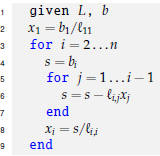
Using forward or backward substitution is sometimes referred to as performing
a triangular solve.
Operations?
Try...
Sketch out an operation count to solve a triangular system of equations...
cheap!
• begin in the bottom corner: 1 div
• row -2: 1 mult, 1 add, 1 div, or 3 FLOPS
• row -3: 2 mult, 2 add, 1 div, or 5 FLOPS
• row -4: 3 mult, 3 add, 1 div, or 7 FLOPS
• ...
• row -j: about 2j FLOPS
Total FLOPS? FLOPS
FLOPS
| Prev | Next |